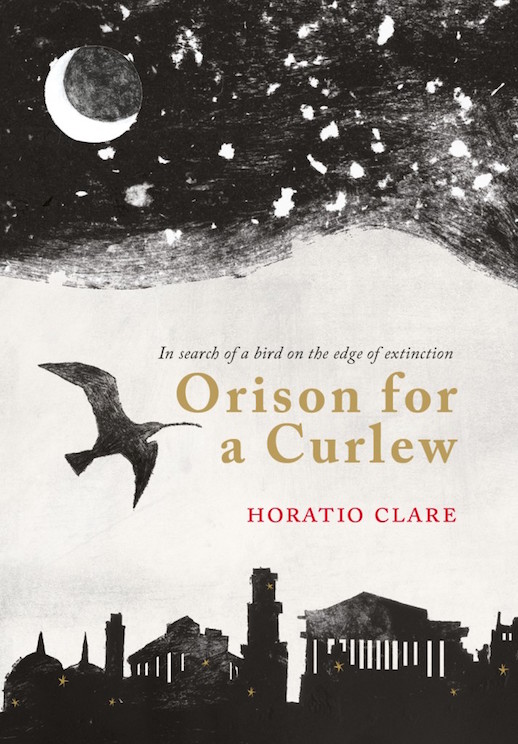 Orison for a Curlew by Horatio Clare
Orison for a Curlew by Horatio Clare
Little Toller, hardback, 104 pages. Out now.
Review by Sue Brooks
In a previous book (A Single Swallow, 2009) Horatio Clare described himself as a romantic…by which I meant that I believed in the powers of life, beauty and art to bring miracles out of everyday existence. He still is. Romantic enough to take on a commission to try to understand the fate of the rarest bird in Europe and lucky enough to find a publisher of a similar mind. Orison for a Curlew is a thing of beauty, a tribute to the willingness of Little Toller Books to invest in those same powers, and invite others, as subscribers and readers, to do the same.
The bird rises on the dust jacket in moonlight over semi-ruined buildings, the distinctive silhouettes of European and Asian cities. It has an apocalyptic feel. Pray For Me, says the title, and Bea Forshall’s delicate engraving on the inside page, shows why we should. A bird graceful and elegant with wings upraised and the long downward-curving beak in the manner of a curlew or a whimbrel, but altogether more refined. The Slender-billed Curlew Numenius tenuirostris. We are being introduced to a ghost that has haunted the imaginations of generations of ornithologists, the handful who have seen it, and the multitudes, like Horatio Clare, who haven’t.
Clare sets out to tell the stories of some of the people whose lives have been changed by a bird that is, as George Handrinos tells him in Athens, very difficult to identify and very, very shy. We eavesdrop on conversations in bars, in taxis, in crowded compartments on night trains, as the characters talk in simple language, not using their native tongue. Clare can make dialogue rise up from the page, so that although there is a brief line of two of physical description, it is hardly needed. In my ear I can hear the voice of Yannis Tsougrakis or Istovan Moldovan or the unforgettable Janos Berthond Kiss, a Hungarian from Transylvania: I met Ceausescu. He shook my hand. He wasn’t even as tall as my dog is long. On Clare’s visit to his home at the southern edge of the Danube delta, they drink a toast in plum brandy made from fruit in Dr Kiss’s garden, to the memory of the Slender-billed Curlew.
I opened my Collins Atlas, revised 1988 edition, to follow the trail, and realised it predated the fall of the Soviet Union. The names were different – Bucuresti (Bucharest) and Sofiya for example – a shocking illustration in my own mental map of what I was reading on the page. In Bulgaria after 1991, in Petar Iankov’s words, Our population has fallen, two million people are abroad. The government is still the same people, the same families as under Communism……We persuaded the government to declare 30% of Bulgaria a Specially Protected Area under EU law. Because we had the data. The government didn’t have any data…….it is like a friend is dying (the Slender-billed Curlew) and I cannot do anything. On this earth things can happen and we cannot do anything, and if we don’t know why then sooner or later it will be our turn. The same Bulgaria whose muddy fields I have seen on the TV News, crossed by exhausted families migrating North.
It is easy to understand why the extraordinary people Clare meets – passionate, committed ornithologists who have devoted their lives in various ways to protect the fragile habitats favoured by the Slender-billed Curlew – seem almost resigned to its fate. Critically Endangered: Red Listed. Possibly extinct. As Clare says towards the end – human activity leaves little room for environmental ambivalence.
And yet, that is not how I felt. I recalled the Evros delta where the Slender billed Curlew has left its mark on the hunting restrictions which protect 10,000 acres – it is more than a collectible Moroccan postage stamp: all these glittering prizes of water and light, the birds, the plants, the insects and the scents, these are partly its gift. And the chapter entitled “Lesson from a ghost”. A ghost leaving footprints and also on the end page, a feather floating in still air. An echo of the hundred hopeful steps rallying call in Robert Macfarlane’s article “Green Shoots and Silver Buckshot”. The bird may never be seen again: no one is sure and many people have cared and still care. There are parts of the world which have so far been inaccessible to European bird watchers – Syria, Iran, Siberia, the Ukraine. They may contain the breeding grounds about which so little is known. Above all this beautiful bird has the allure of the unknown. The last words leave the deepest mark: Too much certainty is a miserable thing, while the unknowable has a pristine beauty and a wonder with no end.
Yes. Yes, and Yes again.
Orison for a Curlew is available from the Caught by the River shop, priced at £12.